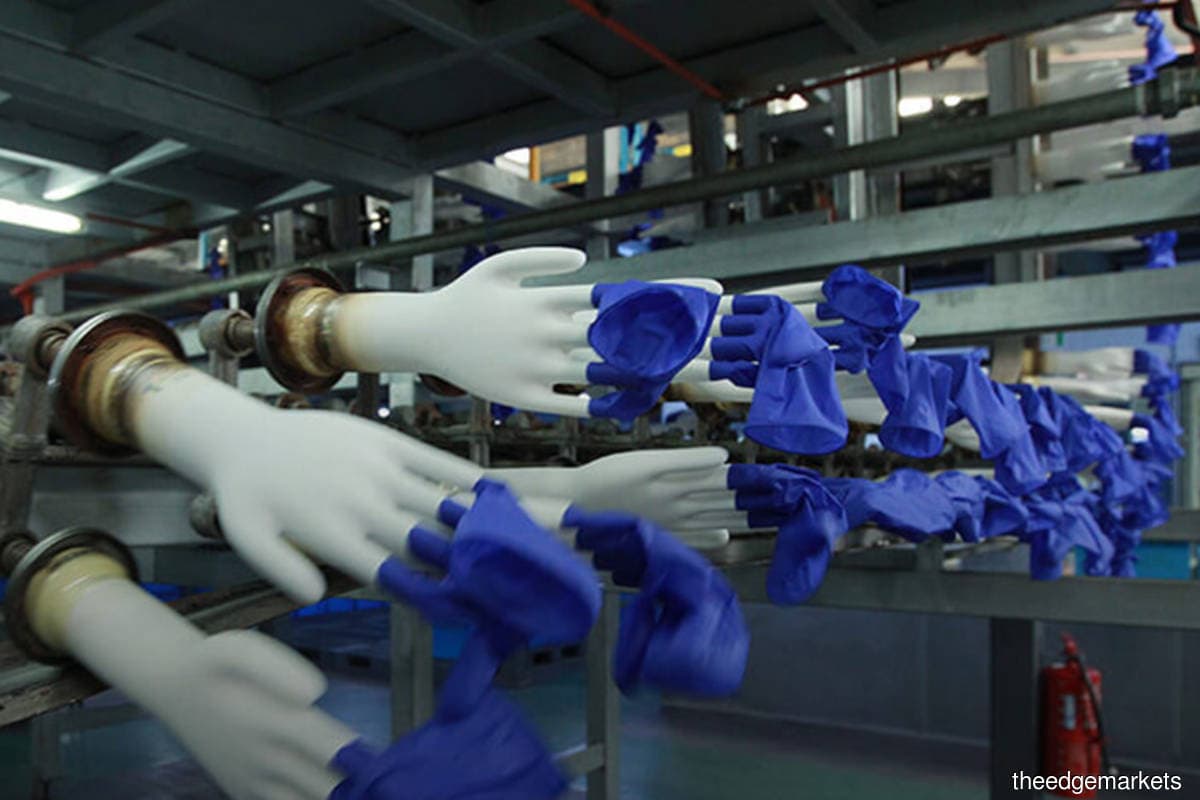
KUALA LUMPUR (Dec 11): JP Morgan has reinstated coverage of Top Glove Corp Bhd, but with an underweight recommendation and a fair value of RM3.50 — that's about half its current market price of RM6.90 — as it sees the passing of a supernormal growth cycle for glove makers, in anticipation of a huge oversupply in the market, as glove demand decelerates in tandem with the pace of testing for Covid-19.
Besides the world's largest rubber glove maker, it also initiated coverage of its closest peers Hartalega Holdings Bhd and Kossan Rubber Industries Bhd, also with UW ratings.
It gave a fair value of RM8.50 for Hartalega, down 38% from its last traded price of RM13.72, and a fair value of RM3.80 to Kossan, which is 30% less than its closing price of RM5.39 today.
Its analysts Jeffrey Ng and YY Cheah, in a note to clients today, said they expect glove prices to weaken in the second half of next year.
"Global testing trends have also plateaued, which ought to ease current supply tightness. JP Morgan’s proprietary fund flow analysis indicates the glove sector is a crowded trade, implying significant downside momentum. Near-term concerns on rising costs, plus long-term overcapacity risk, spell downside risks. Once Malaysia lifts the short selling ban, downward pressure could be amplified," they wrote.
In particular, they noted that 13 of 17 highly populated nations’ testing trends have started to trend downwards from their peaks since the end of September. This, they wrote, may be an early indication that glove prices too have peaked, and similarly for producers’ profits and share prices.
They also view the expectation that the use of gloves per capita would double post Covid-19 as "overly optimistic", given global population growth is substantially slower than projected glove capacity growth.
Glove production capacity, they noted, is expected to grow 87% in the next three- to five years from this year’s, with 130 billion pieces per annum capacity to come from the big four glove makers of Top Glove, Hartalega, Kossan and Supermax Corp Bhd, and 20 billion pieces more from non-conventional players.
“The most worrying factor is oversupply, as we see not only significant capex plans from the big four producers but also from new players. While it is hard to measure the potential oversupply, we can take a leaf from the crude palm oil industry which saw a decade of oversupply post a supernormal cycle in the early 2000s,” they noted.
Additionally, glove makers' profitability is expected to be negatively affected by higher raw material prices and rising labour costs. "Pressure on foreign workers' treatment has and will continue to lift opex. Board members of certain glove producers have also asked for a raise in board fees. All these will add to higher opex and erode margins," they wrote.
Amid all this, they think the upside potential for glove stocks may be capped, with retail and foreign participation having reached all-time highs.
Malaysia’s government linked funds are the only hope to lift the sector, they wrote, yet they have also been trimming their exposure recently.
"The market cap of the top-four producers is RM170 billion, equal to 66% of local non-government-linked funds’ AUM (asset under management). Our proprietary analysis shows most funds have exposure in gloves and their cash holdings are low. To date, local mutual funds have invested 11% of AUM in gloves. Retail and foreign participation are at all-time highs. It is thus difficult to find incremental dollars to drive this sector higher," the note read.
Meanwhile, they noted that Top Glove and Hartalega's capital management decisions have not been optimal for creating value for shareholders due to the focus on accelerating capex via cash to support capacity growth.
“Despite the strong cash generation in the next 12 months, Top Glove has guided that it will maintain a 50% dividend payout, as it aims to increase its capex to RM2 billion per annum for the next five years, a four times increase relative to its historical average. Utilising equity at a cost of 7.7% versus cost of debt of less than 5% to fund capex, in our view, is not optimal to shareholders’ value creation,” it explained.
Similarly, Hartalega's management has guided that it would increase its capex by 2.3 times in the next three years, compared with the financial year ended March 31, 2017 (FY17) to FY19.
The analysts believe Hartalega could unlock more value if it uses its debt to fund capex, as its cost of equity of 7.8% is higher than its cost of debt of 2.5%. "Management has also guided that it will only maintain its 60% dividend payout for the next three years, despite the strong cash generation and supernormal cycle," they added.
Among risks to JP Morgan's sector call is a second global wave of Covid-19 cases, and any unplanned glove production disruption that could create supply tightness — both of which could lift glove prices to new heights.
A relaxation of foreign worker policy or cut in worker levy would also improve profits, so would any greater-than-forecast drop in nitrile and natural rubber prices.
Further challenges to its sector call would be a significant step-up in dividend payout plus capital repayment that would lighten the glove makers' balance sheet, and a substantial depreciation of the ringgit that would improve reported profit, as gloves are sold on US dollar terms.